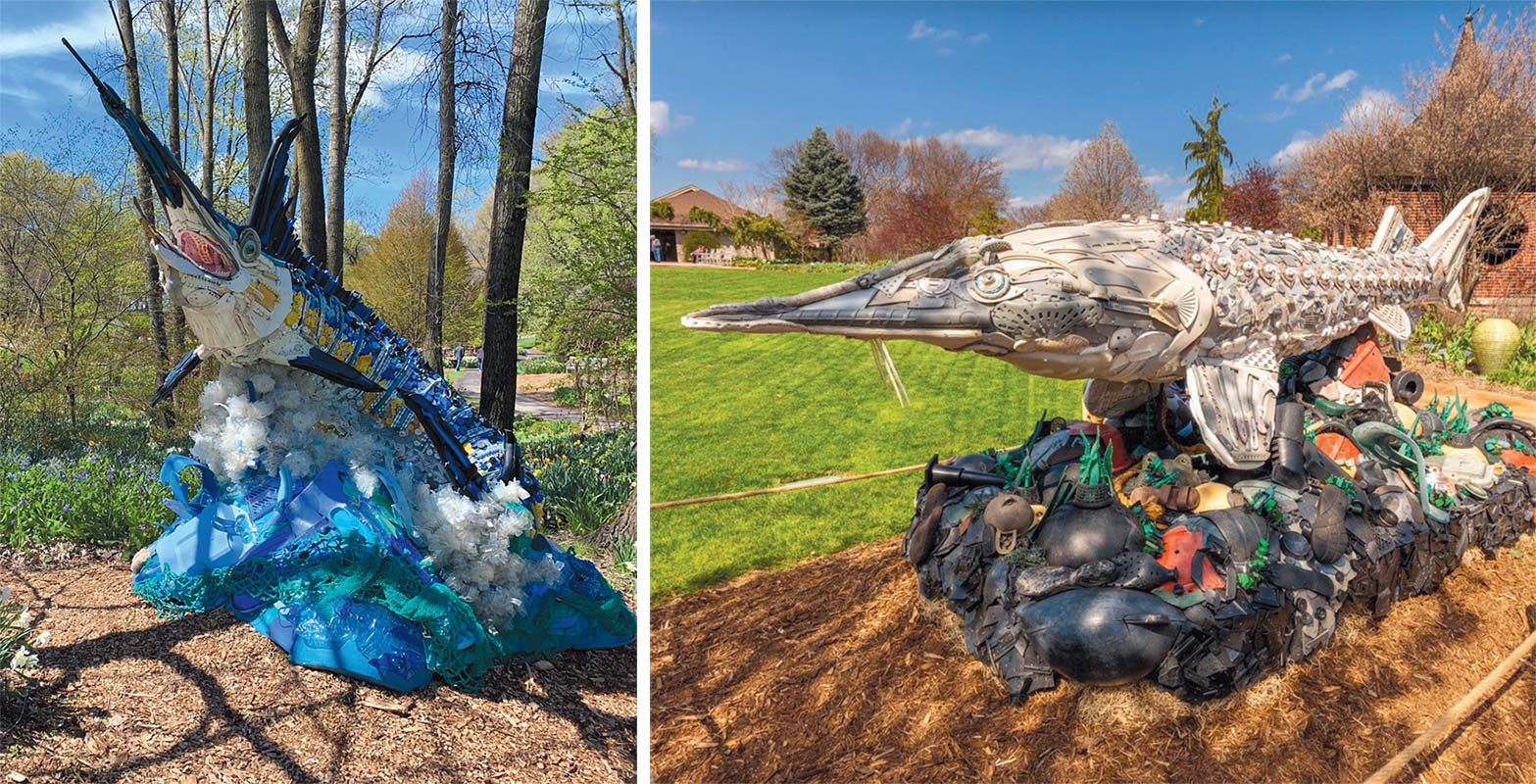Green Bay Botanical Garden’s Powerful Art Exhibit
Looking at the intricately created and meticulously patterned sculptures positioned throughout Green Bay Botanical Garden, it is hard to believe these powerful pieces of art were built from plastic pollution found regularly in our oceans and waterways.
Eight engaging exhibits, each personifying an animal or marine life whose health has been endangered by the trash of which it is made, stand as impactful, community-created fine art that gives a voice to a great cause.
“It’s sobering to think that all this comes out of our waters—from shoes to coolers,” said Sandy Jacques, a longtime Garden member and Herb Society volunteer. “It would be good to bring children to make them more aware.”
Green Bay Botanical Garden is celebrating 25 years of connecting people with plants and providing year-round educational opportunities in an environment that engages, inspires and refreshes. As part of the yearlong anniversary, the traveling “Washed Ashore: Art to Save the Sea” exhibit has its Wisconsin debut at the Garden and is available for viewing through Sept. 26.
“The exhibit will bring awareness and hopefully a call to action about those things we can all do personally to change the way we use plastics and take care of the earth,” said Linda Gustke, director of education and guest experience at the Garden. “Our board and staff believe in sustainability, and these practices have been incorporated into our every day for years.”
Visiting Green Bay for the summer are Chompers the Shark, Priscilla the Parrotfish, Gertrude the Penguin, Flash the Marlin, American Sea Star, Giacometti the River Otter and the Sea Jelly Bloom. Each sculpture stands or spans more than six feet and was created as an educational tool to help spur positive changes in daily habits with water and waste. Making a premiere is Stanley the Sturgeon. Requested by the Garden, the sculpture brings attention to the local area and was recently featured on The Kelly Clarkson Show.
“We wanted to offer a direct connection to the Great Lakes,” Gustke said. “Stanley the Sturgeon will join Giacometti the River Otter in providing a focus on freshwater lakes and streams. Most of the plastics and items built into the sculptures are taken from the oceans, but these very same issues exist in our own back yard in freshwater streams, rivers and our Great Lakes.”
The sculptures’ colors and size are captivating. This is exactly the impact that the Washed Ashore Project Founder Angela Haseltine Pozzi hoped for in the Art to Save the Sea collection. Pozzi, an exhibiting artist and educator for more than 35 years, uses the power of art for community and environmental action. Characters from the collection have been featured nationally, drawing global audiences at such places as the Smithsonian Museum, the United Nations Plaza in New York and at Disney World and Sea World. “The art is unbelievable and amazing,” said Nancy Smith, a visitor to the Garden. “It’s sad, but also good that someone spent the time to repurpose the items like this.”
Washed Ashore is a nonprofit organization based in Brandon, Oregon. Its more than 10,000 volunteers have gathered, sorted and washed up to 30 tons of debris, mainly off the Pacific Coast, to build 85 sculptures and counting. Plastic is mounted on a steel frame. Items in the sculpture might include flip fl ops, water bottles, shotgun shells, bottle caps, plastic handles, lighters, sunglasses, fishing poles and nets, toilet seats or Styrofoam.
It is estimated that the average American throws away 220 pounds of plastic annually, from bottles to food containers and other objects. Plastic also travels over long distances and never truly goes away. Rather, it decomposes into smaller and smaller pieces, and continues to wreak havoc as microplastic, which is the most prevalent plastic pollution in the Great Lakes.
Change can occur through awareness and education. Every sculpture featured at Green Bay Botanical Garden displays an educational board with information about the depicted sea life and the items used to create it. Each board also outlines action items guests can take to reduce plastic usage in their own lives. In addition, discovery boxes, activities and a scavenger hunt with ocean or water-related themes for every age to enjoy have been placed around the Garden. Throughout the summer, Gustke and staff will use the art to teach day camp children as part of Shipwrecked Salvagers about the importance of reusing, reducing and recycling.
“Art is amazing! You can make anything out of it,” said 7-year-old Haley, who visited the Garden for the first time with her family on the exhibit’s opening day. “It’s not good (the plastic) for the animals in the ocean, and it is sad it was in the ocean.”
Gustke loves connecting people with science and the outdoors.
“The sculptures depict animals and sea life adversely affected by the buildup of both large plastic items as well as microplastics that are not only in the water, but also in the air and food,” she said.
Through events, special exhibits, daily programming, and a growing membership, Green Bay Botanical Garden continues its mission of year-round education. The Garden hosts more than 156,000 visitors annually from northeast Wisconsin and beyond.
In recognition of a quarter century of growth and success, The Garden is also planning mini-events on the 25th of every month. A public birthday party and concert is planned for Sept. 25, the month that the Garden opened. In addition, horticulturists have incorporated silver hues into the garden designs in celebration of this milestone year.
Whether the inspiration for change is found in the beauty of plants or the impact of the sculptures, both the Green Bay Botanical Garden and Washed Ashore have a storied history of sustainability through education. Each continues to flourish due to a strong purpose, committed volunteers and enduring community support—with the earth as the beneficiary.
The exhibit is included with daily admission and is free for Garden members.
- For more information about the exhibit, visit GBBG.org/Washed-Ashore.





